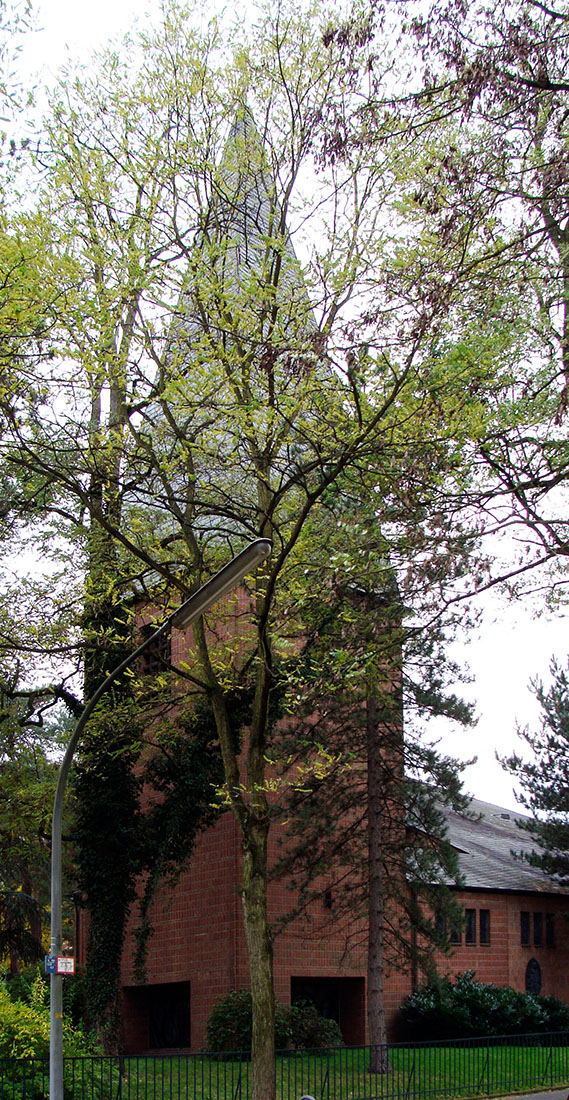 |
 |
 |
 |

Church Maria Königin
Köln-Marienburg
1951 - 1954
The
catholic church Maria Königin in Cologne Marienburg had a longer
history. Already after the turn of the century there were first
thoughts about this intention,
at this time still for a different place in this suburb of Cologne. In the 1930s, the plans became more concrete, but only the extension of a chapel was planed.
Dominikus Böhm, resident in Marienburg, assumed the idea, and pointed out numerous problems. He argued in favor of an independent new construction.
His design for a basilica with compact west tower, however, was prevented by the outbreak of war. In 1951 Dominikus Böhm was again commissioned with
the planning of this church. He developed an entirely new concept, abandoned the idea of a basilica and designed a so-called tent of god. The brick building
was realized on a generous piece of land with several nice mature trees. This church is conceived as cubic volume on a square plan with a single nave,
covered by a slightly pitched pyramid roof. The façade is clad with large, vertically arranged bricks, which are not following a masonry bond. Every three layers
there are horizontal leveling layers of smaller narrow bricks. The entrance façade is sparingly accentuated and shows a glass porch, a row of windows above it
and a bell tower. The nave has been extended on the north side by a lateral wing containing a confessional chapel, sacristy and parish rooms. This lateral wing
results in a transversal extension of the interior.
The simple and open interior is structured only by four slender steel columns, which carry a slightly concave and convex curved ceiling substructure.
The altar stands in front of a flat segmental apse which emerges on the exterior. The southern side wall is completely dissolved in stained glass windows.
In front of the south wall is located an also fully glazed rotunda, containing a lowered baptistery. This is room is connected with the church by a tapered passage.
Twelve reinforced concrete pillars support the completely glazed windows area above ground. During the design and construction process of this church,
Dominikus Böhm collaborated with Heinz Bienefeld who became known as an architect of churches and houses.
at this time still for a different place in this suburb of Cologne. In the 1930s, the plans became more concrete, but only the extension of a chapel was planed.
Dominikus Böhm, resident in Marienburg, assumed the idea, and pointed out numerous problems. He argued in favor of an independent new construction.
His design for a basilica with compact west tower, however, was prevented by the outbreak of war. In 1951 Dominikus Böhm was again commissioned with
the planning of this church. He developed an entirely new concept, abandoned the idea of a basilica and designed a so-called tent of god. The brick building
was realized on a generous piece of land with several nice mature trees. This church is conceived as cubic volume on a square plan with a single nave,
covered by a slightly pitched pyramid roof. The façade is clad with large, vertically arranged bricks, which are not following a masonry bond. Every three layers
there are horizontal leveling layers of smaller narrow bricks. The entrance façade is sparingly accentuated and shows a glass porch, a row of windows above it
and a bell tower. The nave has been extended on the north side by a lateral wing containing a confessional chapel, sacristy and parish rooms. This lateral wing
results in a transversal extension of the interior.
The simple and open interior is structured only by four slender steel columns, which carry a slightly concave and convex curved ceiling substructure.
The altar stands in front of a flat segmental apse which emerges on the exterior. The southern side wall is completely dissolved in stained glass windows.
In front of the south wall is located an also fully glazed rotunda, containing a lowered baptistery. This is room is connected with the church by a tapered passage.
Twelve reinforced concrete pillars support the completely glazed windows area above ground. During the design and construction process of this church,
Dominikus Böhm collaborated with Heinz Bienefeld who became known as an architect of churches and houses.
